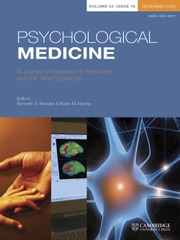Article contents
Psychometric Properties of the Mini International Neuropsychiatric Interview (MINI) Psychosis Module: A Sub-Saharan Africa Cross Country Comparison
Published online by Cambridge University Press: 10 March 2023
Abstract
The Mini International Neuropsychiatric Interview 7.0.2 (MINI-7) is a widely used tool and known to have sound psychometric properties; but very little is known about its use in low and middle-income countries (LMICs). This study aimed to examine the psychometric properties of the MINI-7 psychosis items in a sample of 8609 participants across four countries in Sub-Saharan Africa.
We examined the latent factor structure and the item difficulty of the MINI-7 psychosis items in the full sample and across four countries.
Multiple group confirmatory factor analyses (CFAs) revealed an adequate fitting unidimensional model for the full sample; however, single group CFAs at the country level revealed that the underlying latent structure of psychosis was not invariant. Specifically, although the unidimensional structure was an adequate model fit for Ethiopia, Kenya, and South Africa, it was a poor fit for Uganda. Instead, a 2-factor latent structure of the MINI-7 psychosis items provided the optimal fit for Uganda. Examination of item difficulties revealed that MINI-7 item K7, measuring visual hallucinations, had the lowest difficulty across the four countries. In contrast, the items with the highest difficulty were different across the four countries, suggesting that MINI-7 items that are the most predictive of being high on the latent factor of psychosis are different for each country.
The present study is the first to provide evidence that the factor structure and item functioning of the MINI-7 psychosis vary across different settings and populations in Africa.
- Type
- Original Article
- Information
- Copyright
- Copyright © The Author(s), 2023. Published by Cambridge University Press
Footnotes
This article has been updated since its original publication. A notice detailing this change can be found here: https://doi.org/10.1017/S0033291723003835
References
A correction has been issued for this article:
- 6
- Cited by
Linked content
Please note a has been issued for this article.



